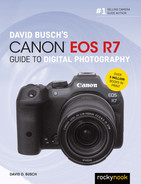Preface
The Canon EOS R7 is the compact, APS-C mirrorless camera that Canon enthusiasts have been waiting for. It includes the most-requested features—including two high-speed UHS-II memory card slots, extended battery life, the ability to power the camera over USB while charging the battery, and improved eye/face tracking of humans, animals, or vehicles.
It offers impressive five-axis image stabilization, with up to 8 stops of anti-shake properties with certain lenses. Yet, it has controls and menus that veteran Canon owners will find comfortably familiar and new users will grow to love as they explore its exciting enhancements. Every photo enthusiast will easily master the camera’s capabilities, even though the sheer number of features and options can be daunting. The only thing standing between you and pixel proficiency is the disappointing booklet furnished in the box as a manual, and an advanced guide from Canon available only as a downloaded PDF file.
Everything you need to know is in there, somewhere, but you don’t know where to start, nor how to find the information you really need to master your camera. In addition, the Canon camera manual doesn’t offer much guidance on the principles that will help you master digital photography. Nor does it really tell you much about how mirrorless shooting might differ from the kinds of digital photography you may already be used to. If you’re like most enthusiasts, you’re probably not interested in spending hours or days studying a comprehensive book on digital photography that doesn’t necessarily apply directly to the enhanced features of your camera.
What you really need is a guide that explains the purpose and function of the camera’s basic controls, available lens options, and most essential accessories from the perspective of mirrorless cameras. It should tell you how you should use them, and why. Ideally, there should be information about the exciting features at your disposal, how to optimize image quality, when to use exposure modes like Aperture- or Shutter-priority, or the new, versatile Flexible-priority mode. In many cases, you’d prefer to read about those topics only after you’ve had the chance to go out and take a few hundred great pictures with your new camera. Why isn’t there a book that summarizes the most important information in its first two or three chapters, with lots of illustrations showing what your results will look like when you use this setting or that? This is that book.
If you can’t decide on what basic settings to use with your camera because you can’t figure out how changing ISO or white balance or focus defaults will affect your pictures, you need this guide. I won’t talk down to you, either; this book isn’t padded with dozens of pages of checklists telling you how to take a travel picture, a sports photo, or how to take a snapshot of your kids in overly simplistic terms. There are no special sections devoted to “real-world” recipes here. All of us do 100 percent of our shooting in the real world! So, I give you all the information you need to cook up great photos on your own!
